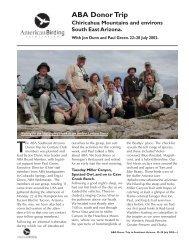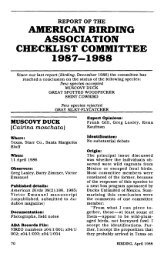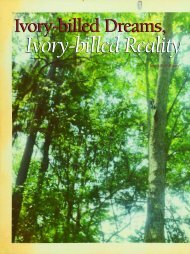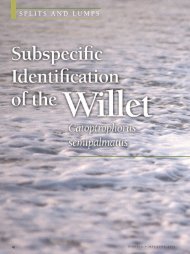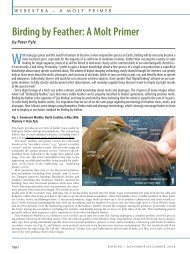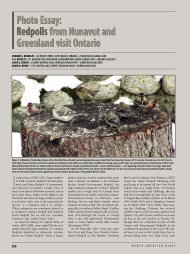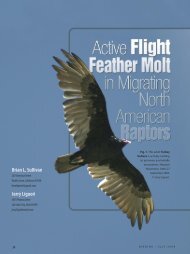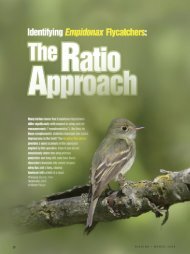Where’s Waldo? Note <strong>the</strong> gray-<strong>and</strong>-white flycatcher <strong>in</strong> <strong>the</strong>upper right portion <strong>of</strong> <strong>the</strong> photo; this bird appeared <strong>in</strong> <strong>the</strong>same yard <strong>and</strong> on <strong>the</strong> same date as <strong>the</strong> bird depicted onp. 30. Birders who attempted to identify this bird—eventuallydeterm<strong>in</strong>ed to be <strong>Nova</strong> <strong>Scotia</strong>’s first photo-documented<strong>Gray</strong> <strong>K<strong>in</strong>gbird</strong>—were challenged by <strong>the</strong> problematic quality<strong>of</strong> <strong>the</strong> image, as well as by <strong>the</strong>ir own notions about what<strong>the</strong> bird was or wasn’t. Photo by © Marilyn O’Brien.to be a median-coverts w<strong>in</strong>g bar, but any o<strong>the</strong>r paleedg<strong>in</strong>gs on <strong>the</strong> bird’s greater coverts <strong>and</strong> flight fea<strong>the</strong>rsare presumably obscured by <strong>the</strong> w<strong>in</strong>g angle <strong>and</strong> poorfocus. It does not at all resemble <strong>the</strong> image <strong>of</strong> <strong>the</strong> firstbird, but it readily fits Ash-throated Flycatcher, a rarebut annual vagrant to <strong>the</strong> Atlantic coast from <strong>the</strong> mid-Atlantic region north to Atlantic Canada.Of those who commented on <strong>the</strong> orig<strong>in</strong>al, low-resolutionimage posted to F-ID, only three were for <strong>Gray</strong><strong>K<strong>in</strong>gbird</strong>, one was for a (tail-worn) Eastern <strong>K<strong>in</strong>gbird</strong>,six were for Ash-throated Flycatcher or some o<strong>the</strong>rMyiarchus, four were for Black Phoebe, <strong>and</strong> two wereIn this close-up, <strong>the</strong> arrows <strong>and</strong> annotations were used to obta<strong>in</strong>measurements analyzed <strong>in</strong> <strong>the</strong> text. The distance between <strong>the</strong> twosmall branches was measured by Lauff, who also determ<strong>in</strong>ed that<strong>the</strong> dark area left <strong>of</strong> <strong>the</strong> head is a background feature, <strong>and</strong> that <strong>the</strong>white areas beh<strong>in</strong>d <strong>the</strong> nape are magnolia buds. The small, pale, triangularfeature just beyond <strong>the</strong> arrowhead at <strong>the</strong> primary tip wasalso found to be a background feature, not a projection <strong>of</strong> <strong>the</strong> limbcutt<strong>in</strong>g <strong>of</strong>f a “true” primary tip beyond. Photo by © Marilyn O’Brien.W W W . A B A . O R G 31
P E R I L S O F O N L I N E I D E N T I F I C A T I O Nfor Eastern Phoebe. Three, perhaps wisely, considered <strong>the</strong> birdto be unidentifiable from <strong>the</strong> photo. Later, Lauff obta<strong>in</strong>ed <strong>the</strong>full-resolution image from <strong>the</strong> photographer. He also downloadedstill images from her video <strong>of</strong> <strong>the</strong> second flycatcher.Contributors to F-ID raised several objections to <strong>the</strong> identification<strong>of</strong> <strong>the</strong> first bird as a <strong>Gray</strong> <strong>K<strong>in</strong>gbird</strong>. O<strong>the</strong>r objectionswere raised <strong>in</strong> private exchanges with those contributors <strong>and</strong>by o<strong>the</strong>rs. Among <strong>the</strong> various objections, some certa<strong>in</strong>ly wererelated to <strong>the</strong> quality <strong>of</strong> image posted onl<strong>in</strong>e. O<strong>the</strong>rs were not.Here is a summary <strong>of</strong> <strong>the</strong> objections:1. The occurrence <strong>of</strong> two greatly displaced vagrant flycatcherson <strong>the</strong> same November day <strong>in</strong> <strong>the</strong> same backyardseemed highly improbable to some. Thus, some observersassumed that <strong>the</strong> reports from O’Brien’s yard <strong>in</strong> Lanarkmust have perta<strong>in</strong>ed to only one bird. However, laggardmigrants <strong>and</strong> vagrants <strong>in</strong> severe wea<strong>the</strong>r are well known toassociate with each o<strong>the</strong>r, perhaps because <strong>the</strong>y f<strong>in</strong>d highlylocal, reliable food sources <strong>and</strong>/or because <strong>the</strong>y recognizesimilar foragers. In this regard, we note that several warblerspecies are found rout<strong>in</strong>ely <strong>in</strong>to early w<strong>in</strong>ter <strong>in</strong> a shortstretch <strong>of</strong> p<strong>in</strong>es <strong>in</strong> Po<strong>in</strong>t Pleasant Park, Halifax, <strong>Nova</strong> <strong>Scotia</strong>.With regard to <strong>the</strong> present matter, we note thatO’Brien’s back yard conta<strong>in</strong>ed unharvested apples, whichare known to susta<strong>in</strong> fly<strong>in</strong>g <strong>in</strong>sects <strong>and</strong> attract <strong>in</strong>sectivorousbirds <strong>in</strong> early w<strong>in</strong>ter.2. The behavior <strong>of</strong> <strong>the</strong> bird, huddled on a low branch, was too“unk<strong>in</strong>gbird-like” for o<strong>the</strong>rs. However, remote vagrants <strong>in</strong>severe wea<strong>the</strong>r—<strong>the</strong> temperature was near freez<strong>in</strong>g on 18November—<strong>of</strong>ten behave unexpectedly. For example, a<strong>Gray</strong> <strong>K<strong>in</strong>gbird</strong> l<strong>in</strong>ger<strong>in</strong>g <strong>in</strong> November 2006 near <strong>the</strong> tip <strong>of</strong><strong>the</strong> Gaspé Pen<strong>in</strong>sula <strong>in</strong> Québec spent time feed<strong>in</strong>g on seabuckthorn (Hippophae rhamnoides) berries, <strong>and</strong> a publishedimage shows it perched on a low shrub (Bannon et al.2007). One respondent noted that a <strong>Gray</strong> <strong>K<strong>in</strong>gbird</strong> <strong>in</strong>Ma<strong>in</strong>e <strong>in</strong> early November 2010 spent some time perchedlow, <strong>and</strong> an <strong>in</strong>ternet image <strong>of</strong> that bird shows that bird huddledon thick spruce foliage . Ano<strong>the</strong>r<strong>in</strong>ternet photo <strong>of</strong> a <strong>Gray</strong> <strong>K<strong>in</strong>gbird</strong> 23 October 2010 atSavannah, New York, shows a bird perched on a branch <strong>in</strong><strong>the</strong> middle <strong>of</strong> a small tree .3. The <strong>in</strong>itial observer did not see a mask, although that markwas anticipated <strong>and</strong> noted by <strong>the</strong> second, experienced observer.The mask <strong>of</strong> <strong>the</strong> <strong>Gray</strong> <strong>K<strong>in</strong>gbird</strong> is not obvious onunderexposed or low-light <strong>in</strong>ternet images.4. Several people believed that <strong>the</strong> tertials were too prom<strong>in</strong>entlywhite marg<strong>in</strong>ed for <strong>Gray</strong> <strong>K<strong>in</strong>gbird</strong>, more resembl<strong>in</strong>gthose <strong>of</strong> Ash-throated Flycatcher. The image is “s<strong>of</strong>t,” <strong>and</strong>that may overemphasize breadth <strong>of</strong> <strong>the</strong> white fr<strong>in</strong>ges by render<strong>in</strong>gmarg<strong>in</strong>al pixels as white. This feature is very variableamong <strong>in</strong>ternet images; some, <strong>in</strong>clud<strong>in</strong>g two juvenilesshown <strong>in</strong> Birds <strong>of</strong> North America Onl<strong>in</strong>e (Smith <strong>and</strong> Jackson2002), have white marg<strong>in</strong>s as conspicuous as, or more sothan, those <strong>of</strong> <strong>the</strong> <strong>Nova</strong> <strong>Scotia</strong> bird.5. O<strong>the</strong>rs <strong>in</strong>voked <strong>the</strong> brownish washes on <strong>the</strong> crown, back,<strong>and</strong> tail <strong>of</strong> <strong>the</strong> bird as a trait for Ash-throated Flycatcher.However, Pyle (1997) notes for <strong>Gray</strong> <strong>K<strong>in</strong>gbird</strong> that <strong>the</strong> juvenile,from August until <strong>the</strong> second half <strong>of</strong> November, has“upperparts washed brownish.” The head, lower back,w<strong>in</strong>gs, <strong>and</strong> tail <strong>of</strong> a recently molted Ash-throated are considerablydarker <strong>and</strong> browner.Fur<strong>the</strong>r Analysis: The Ratio ApproachTo <strong>in</strong>vestigate <strong>the</strong> matter fur<strong>the</strong>r, we attempted to extract more<strong>in</strong>formation from <strong>the</strong> higher-resolution image us<strong>in</strong>g <strong>the</strong> measuredapproximately 223-millimeter distance between twobranches on <strong>the</strong> foreground limb (see <strong>in</strong>set, p. 31). If <strong>the</strong> birdwas perched reasonably parallel to that limb, <strong>the</strong>n its apparentsize would exclude both phoebes, but not Ash-throated Flycatcher.If <strong>the</strong> branch was parallel to <strong>the</strong> plane <strong>of</strong> <strong>the</strong> image,<strong>and</strong> <strong>the</strong> bird was perched at an angle, <strong>the</strong> bird could be evenlarger. But, if <strong>the</strong> bird was parallel to <strong>the</strong> plane <strong>of</strong> <strong>the</strong> image,<strong>and</strong> <strong>the</strong> measured branch was as much as 45 o <strong>of</strong>f that plane(very unlikely from <strong>in</strong>spection <strong>of</strong> <strong>the</strong> photo), simple geometrywould <strong>in</strong>dicate that <strong>the</strong> bird’s true size could fall with<strong>in</strong> <strong>the</strong>size range for <strong>the</strong> two phoebes.An alternative approach us<strong>in</strong>g ratios <strong>of</strong> measurements fromimages is more trouble-free. McLaren (1996) used this approachto help identify <strong>the</strong> prov<strong>in</strong>ce’s first confirmed AcadianFlycatcher, <strong>and</strong> it has recently been explored for separat<strong>in</strong>g <strong>the</strong>wood-pewees (Lee et al. 2008) <strong>and</strong> for resolv<strong>in</strong>g differencesamong Empidonax flycatchers (Rowl<strong>and</strong> 2009). Us<strong>in</strong>g such ratiosrequires only that <strong>the</strong> two measured parts be reasonablycoplanar. In <strong>the</strong> image <strong>of</strong> <strong>the</strong> first bird, <strong>the</strong> distance from <strong>the</strong>base <strong>of</strong> <strong>the</strong> exposed tertials (that is, <strong>the</strong> edge <strong>of</strong> <strong>the</strong> greatercoverts) to <strong>the</strong> tip <strong>of</strong> <strong>the</strong> primaries as a proportion <strong>of</strong> <strong>the</strong> distanceto <strong>the</strong> tip <strong>of</strong> <strong>the</strong> tail is 0.49. We also estimated this ratioon ten good <strong>in</strong>ternet images <strong>of</strong> <strong>the</strong> two large c<strong>and</strong>idate species,<strong>Gray</strong> <strong>K<strong>in</strong>gbird</strong> <strong>and</strong> Ash-throated Flycatcher; <strong>the</strong>se were birdsperched more or less broadside, with <strong>the</strong> w<strong>in</strong>gs <strong>and</strong> tail <strong>in</strong> l<strong>in</strong>ewith <strong>the</strong> body. For <strong>Gray</strong> <strong>K<strong>in</strong>gbird</strong>, <strong>the</strong> arithmetic mean <strong>of</strong> thisratio was found to be 0.51, with a range <strong>of</strong> 0.48–0.54. ForAsh-throated Flycatcher, <strong>the</strong> arithmetic mean was 0.43, witha range <strong>of</strong> 0.40–0.47. On this basis, <strong>the</strong> bird <strong>in</strong> O’Brien’s backyard <strong>in</strong> Lanark lies with<strong>in</strong> <strong>the</strong> range <strong>of</strong> <strong>Gray</strong> <strong>K<strong>in</strong>gbird</strong> but outside<strong>the</strong> limit <strong>of</strong> Ash-throated Flycatcher, consistent with <strong>the</strong>relatively short w<strong>in</strong>gs <strong>and</strong> long tail <strong>of</strong> Ash-throated.Ma<strong>the</strong>matically <strong>in</strong>cl<strong>in</strong>ed readers will be <strong>in</strong>terested to know32B I R D I N G • J U L Y 2 0 1 1



